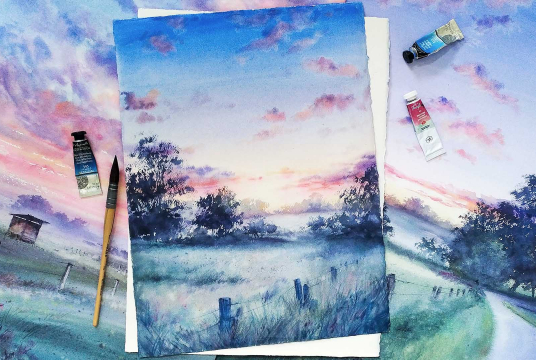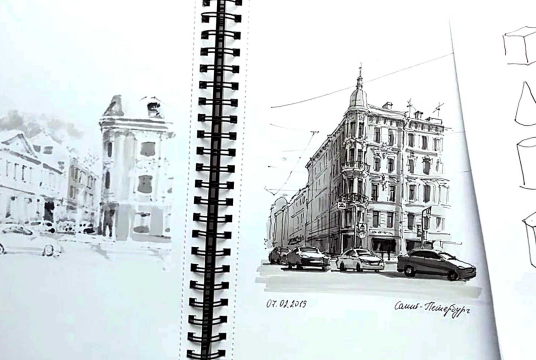The materials used for this work:
Paper:
- Cotton watercolor paper Arches, texture Grain Torchon (Rough), 300 gsm
The watercolor is made on a 38x28 cm sheet.
For this work the cotton watercolor paper with Fin texture (Cold pressed) is better suited, including any other brand, with a density of at least 200 gsm (better - 300 gsm).
- Cellulose and cotton paper of any density for exercises, color tests and sketches.
In this lesson, sheets of thin cellulose drawing paper (for sketches and drafts) and cotton watercolor paper Fabriano, Grain fin texture with a density of 300 gsm (for exercises) were used.
Brushes:
- Wide flat goat brush
- Squirrel brush with a pointed tip, 10 mm (can be replaced with a squirrel-mix or squirrel imitation)
- Round synthetic brushes, 2-4 mm (any round resilient) with a small pointed tip will fit.
Watercolor paints:
You can use paints of similar colors from any manufacturer in tubes or pans, but before you start don't forget to check which colors your paints give when mixed with each other.
- Phthalocyanine Turquoise (Sennelier 341)
- Orange Sennelier (Sennelier 641)
- Red French Vermilion (Sennelier 675)
- Payne's Grey (Sennelier 703)
- Blue Sennelier (Sennelier 399)
- Deep ultramarine blue (Sennelier 315)
- Naples Yellow (Sennelier 566) - not much, you can do without it.
Indigo, indanthrene blue, emerald, etc. may also be suitable for this painting.
Other:
- Pulverizer (with small drops)
- Plastic tablet, size 30x40 cm
- HB pencil and erasers: regular and soft
- Paper towels
- Paper adhesive tape
- Plastic Palette
- Water
Music: bensound.com




















